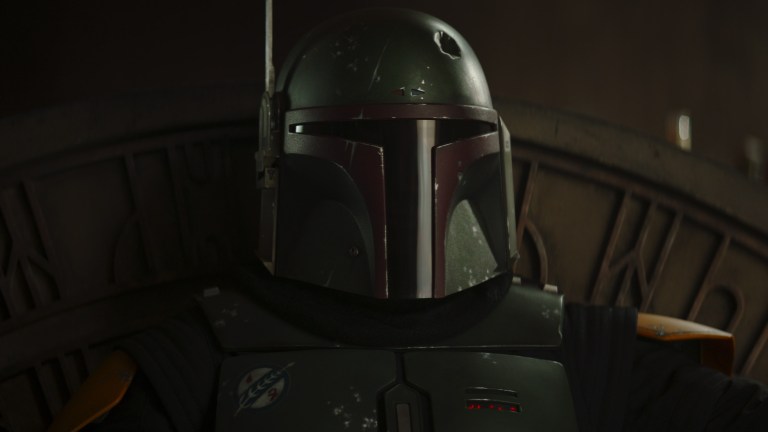Star Wars: How Boba Fett Defined a Generation of Lucasfilm Characters
Despite only having four lines and six minutes of screen time in the original trilogy, the bounty hunter is a fan favorite getting his own show—but then this is the myth making that Lucasfilm does best.

On Dec. 29, Star Wars fans will finally get something they could only fantasize about in 1983: the further on-screen adventures of Boba Fett. It’s a Disney+ show almost 40 years in the making, and not just because the pre-Disney canon had already established Boba survived the sarlacc pit, but because the villain always seemed destined for something bigger than his six-ish minutes of screen time and four lines of dialogue in the Original Trilogy.
Boba is a great example of the kind of zeitgeist-grabbing myth-making that has made Lucasfilm such a successful movie studio over the last 50 years. As with other memorable Lucasfilm icons, including Indiana Jones, the studio put a lot of time into designing the bounty hunter. In fact, the creation of Boba Fett is emblematic of Lucasfilm’s signature approach to character building and the massive success of that process.
Before 1980’s The Empire Strikes Back, there was already Boba Fett. While he made his on-screen debut in the animated segment of ‘78’s Star Wars Holiday Special as a bounty hunter, Boba was actually born as a new kind of stormtrooper in the concept art of the legendary Ralph McQuarrie and art director Joe Johnston. The design for an Imperial armor equipped with a jetpack, rocket launcher, and middle ages-inspired helmet soon jumped off the page and onto a Lucasfilm lot. The first prototype of the suit was worn by assistant film editor Duwayne Dunham during an internal reveal of the character at the studio, when the character’s makeshift cape was just a Star Wars towel.
But when it was decided that there wasn’t enough money to make multiple versions of the prototype for Empire, Lucas once again turned to film history and the storytelling formula that had brought him blockbuster success in ‘77. As with Darth Vader, Luke Skywalker, Princess Leia, and Han Solo, Lucas cherry-picked a specific archetype and movie influence for his mysterious bounty hunter to not only establish his backstory but imbue him with a familiarity that communicated who this character was on a visceral level. Even if you didn’t know anything about Boba Fett, you could understand the film language. Boba was the galaxy’s version of the man with no name from spaghetti westerns—a cold, brooding Clint Eastwood in space, right down to his spurs and old-timey blaster.
Boba Fett’s first real public debut was at the San Anselmo Country Fair parade in California on Sept. 24, 1978, months before the Holiday Special and before anyone knew a single thing about the character. But the genius of Star Wars at the time was that it could introduce plenty of mysteries—the Force, the Jedi, an entire lived-in galaxy—without having to spend hours addressing all the mumbo jumbo head on. The fun of the galaxy far, far away was the insinuation of deeper lore that you ultimately made up yourself while playing Star Wars in the schoolyard with your friends.
Lucasfilm’s youngest fans have always been key to the studio’s success. Falling in love with the Flash Gordon and Buck Rogers serials of the 1930s, Lucas learned firsthand of the lasting impression movies could have on children—and not just through their playground years. The right story could stick with the viewer forever. It’s why Lucas envisioned Star Wars as a series of morality tales that taught kids about “friendships, trust, doing the right thing, living on the right side, and avoiding the dark side.”
It’s perhaps also why Boba Fett made his on-screen debut in The Star Wars Holiday Special, an extravaganza once again aimed at the kids. Cynics might argue that Boba was introduced on national primetime TV to create hype for the Kenner action figure also coming out in ‘78 (and that’s undoubtedly true), but the platform was also perfect for building the legend of the character itself. Introducing “the next big thing” in Star Wars directly to children on a special night in November would soon turn into kids playing with their Boba Fett toys and costumes, imagining what adventures the bounty hunter might go on next. Decades later, those kids are parents taking their own children to see Star Wars in theaters and buying them Boba Fett Halloween costumes. Boba, like the rest of the Star Wars characters you know by heart, have been immortalized because Lucasfilm knew who they were making these movies for.
Duwayne Dunham reveals in the recent Boba Fett making-of documentary, Under the Helmet, that the only reason he was chosen to wear the prototype was because he was the right size. The bounty hunter was later brought to the big screen by actor Jeremy Bulloch, who wore the suit in Empire and Return of the Jedi, but he didn’t voice the character. That was Jason Wingreen, before the bounty hunter’s voice was retconned to sound like Temuera Morrison in later remasters of the Original Trilogy. The character will next be played by Morrison in The Book of Boba Fett on Disney+.
But it’s Dunham, the first man to wear the iconic armor, who remembers the anxiety among some at Lucasfilm when Lucas decided that it was time to kill off Boba, telling Star Wars.com, “We kinda mounted a protest saying ‘You can’t do that to Boba Fett! He’s deserving of more!’ But they threw him in… and as you know, fans have never let him die.”
The Book of Boba Fett arrives on Disney+ on Dec. 29.
